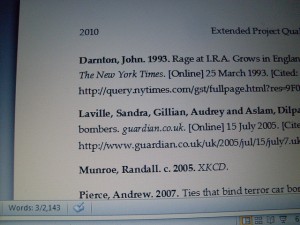What’s A Bibliography And Why Do I Need It?

Last week, we have talked a bit about citation and how to properly cite other author’s work when you didn’t get any guidelines from your tutor or professor. A scientific paper or college essay is not complete without a library of sorts that collect all your citation sources and groups them together. Of course we are talking about a bibliography.
What’s A Bibliography?
Plain and simple said, a bibliography is a list of sources you have used in the research process of your work. Those materials include books, chapters, articles, papers, essays and even webpages. It is usually found at the end of your work and gives an overview of all cited and used material in your paper.
What distinguishes the bibliography from a reference list, however, is that it contains all reading and research material used for your work, not only the articles and authors you have cited in your work. Read something you only briefly mentioned in your paper or that, sadly, didn’t find it’s way in due to not being as relevant as other work? It will nevertheless find it’s rightful spot in the bibliography.
What Should A Bibliography Contain?
There are a few mandatory pieces of information that should be included in your bibliography. Some departments and lecturers have guidelines on how a bibliography entry should look like. If you have a guide like this: follow it. If not, make sure the following information is included in any case:
- The name of the Author(s)
- The title of their work
- The publishing date of the work
- Information about the publishing company (name, location)
- In case of books:
- the volume number if the book is part of a series
- the chapter number if only one chapter was really relevant
- the name of the book author if the author of your cited work only wrote that particular chapter
- In case of magazine articles:
- the magazine title and volume the article/paper appeared in
- In case of web sources:
- the URL of your web source
- the date of the last access
Why Do I Need A Bibliography?

The easy answer here would be that, in many if not most cases, a bibliography is mandatory for research papers, essays and other term papers. However, there are some good arguments for why you should include one in your work.
The first reason is: for the reader’s benefit. When reading a paper or article on a new topic, especially if it’s rather controversial, your lecturer, colleagues or critics of course want to know which previous work you have included in your research. A brief look at the bibliography already tells those who know what to look for how deep, profound and reliable your research has been. When your bibliography includes some big names and recent work in the field of your research, you are way more likely to impress than when your bibliography contains outdated and mostly unknown material.
On the other hand, a student or interested reader can have a look at the bibliography of your paper to find out if the read is “worth it” or maybe even crucial for their own research. If they write about one of the authors in your bibliography, your work may be interesting and important for their own paper as well.
Of course you yourself benefit from a bibliography as well. Stumbled upon a great article for your paper but you aren’t completely sure if it is included already? Check your bibliography. Maybe you have used and cited other works of the author already, then a look at your new found resource is well worth the read. In general, the bibliography is very useful for quick checks of used materials, articles you may have or need, etc.
Other Forms
Another form of bibliography is the annotated bibliography. Such an annotated list does not only contain the work of another author, but additional information as well, such as:
- An abstract or summary of the content
- A note about the quality of the material
- A note about how useful the source has been for your work
